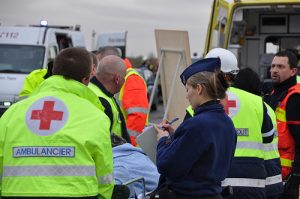 In March, the Aubia Communications Blog will discuss crisis communications. I begin with this post on what needs to happen before, during and after a crisis event; then I compare two companies’ differing responses to social media crises; and finally a post about potential signs a crisis is looming will round out the conversation.
In March, the Aubia Communications Blog will discuss crisis communications. I begin with this post on what needs to happen before, during and after a crisis event; then I compare two companies’ differing responses to social media crises; and finally a post about potential signs a crisis is looming will round out the conversation.
Around 3 p.m. (EST) Nov. 5, 2009, I was taking photos for the installation newspaper of military spouses at the USO Center on Fort Eustis in Virginia packing cookies to send to Soldiers in Iraq and Afghanistan for the upcoming holidays. The TVs in the center suddenly turned to breaking news and people’s smart phones began receiving alerts. There had been a massive shooting on Fort Hood in Texas. What had been a cheerful event centered around talk of how families were including Soldiers far from home in holiday festivities suddenly turned into a solemn occasion of concerned spouses and Soldiers praying for the safety of their brothers and sisters in arms.
As I immediately left the USO Center heading to my office, pulling a statement together in my head from established crisis communications plans, my cell phone began ringing with queries from local reporters about any change in status of Fort Eustis. I was able to give a basic response with a promise to contact them back shortly with more information. Once I was able to get back to my office and speak with all the key players of the crisis response team, I had a full statement to provide to all three local TV networks and two regional newspapers plus a drop to the AP. I also conducted three live voiceover interviews for the evening news broadcasts.
Prepare for a crisis when the sun is shining. –Gerard Braud
Crises can be just around the corner for any organization, and it’s essential to your reputation to be prepared for them. I concentrate solely on the communications aspect of a crisis, but keep in mind your communications efforts need to be in line with operational strategies for dealing with a crisis.
Crisis communications is also not just for organizations. If you’re a solopreneur, having a strategy in place for yourself can prove useful in emergencies. Take the items below and adjust them to your particular business structure.
Before a crisis strikes your company, here are some items to have in place.
1. Crisis Communications Plan
Wouldn’t it be much easier to pull a plan to work from instead of scrambling with what to do when disaster hits? A crisis communications plan should, at the minimum, include fill-in press releases and messages; mediums for how you will get the messages out; a contact list of spokespersons whose expertise would be needed in a crisis; an identified area for a media center with listed resources; and an identified area for a crisis center separate from the media center with listed resources. Other information can include logs for calls received; a media list; bios of spokespersons and major equipment; allocated times and locations for press conferences; and means for escorting media to the scene of the crisis or providing visuals.
2. Crisis Response Team
A team of experts from various departments that can assist in a crisis should be identified and a contact list should be kept up-to-date for these individuals. An area where the team can meet at the onset of the crisis to execute the crisis communications plan should also be identified with resources needed to accomplish the meeting.
3. Training
Each staff member should be trained on how the crisis communications plan works. Media training should be provided to each employee on a yearly basis, but identified spokespersons should receive more thorough media training.
At least once a year, your crisis communications plan should be executed in a mock crisis. Practicing helps employees see and act out the concepts they’ve read on paper, and when the real deal comes, they’ll know what and how to do it.
During a crisis, takes these steps.
1. Activate and execute your plan.
This is what all your training and practice has come down to. Activate your plan and work through your steps. The goal of handling a crisis successfully is to come out the other side with a maintained, even better, a strengthened, reputation.
2. Do what you say you’re going to do.
You need to be flexible enough in your plan to make adjustments when needed, but you need to stick to what you outline. If you said you’re going to give a press conference every afternoon at 3 p.m., do it even if there is no new information. If your organization has promised to make a change in operations due to the crisis, show how the change is coming about.
3. Monitor your progress.
In the crisis is when you need to start evaluating how you’re doing. What are the news reports saying about the crisis? What are your customers saying? Is there something you can adjust to make your handling of the situation better? Use this information to your advantage and later to follow up on in the assessment after the crisis ends.
4. End the crisis.
It’s always better to end a crisis sooner rather than later. Lingering crises can further damage your reputation and bottom line. Activate and execute your plan, apologize if need be, say and do what it will take to fix the problem, and move on.
After the crisis, be sure you do the following things.
Look at the press. Check out your social media platforms. Review your financial information. Any crisis is going to have an effect on your organization, but how you handled it will determine how large of an effect. What did your clients like about how you managed the situation? What didn’t they like? What parts of your plan worked well? What can be improved for the next crisis (and there will be a next crisis)?
2. Make needed changes.
Evaluation is pointless if you don’t learn from it. If you’re media center wasn’t equipped with the right equipment and you don’t update, the next time you’ll have some unforgiving reporters on your hands. Update your plan so you’ll be even more prepared for the next time disaster strikes.
3. Issue a follow-up report.
This one can be tricky. During a crisis you don’t always have the time and resources to fully examine what went wrong and how to completely fix the problem. One of your messages is most likely to be that your organization is going to conduct a thorough investigation into the matter and make changes if and where necessary. After the crisis is over, don’t forget this (see No. 2 in what to do during a crisis). After the investigation is complete, do you issue the report and risk bringing it back into the forefront of your audiences’ minds? Or do you just keep quiet since no one is talking about it anymore? I always opt for a proactive stance. If you release the report upfront, this saves you from the media member who comes back around on the year anniversary of the event demanding the report you promised.
Crisis communications is an always-evolving cycle. Be sure you are prepared, take action, evaluate, learn from it, and move on. Crises are opportunities for your organization, and if you view them as such, you can come out better than ever.
What examples of crisis communications have you learned from?
photo credit: mdanys via photopin cc
photo credit: USAG Benelux via photopin cc
photo credit: cmediaworkshop via photopin cc





